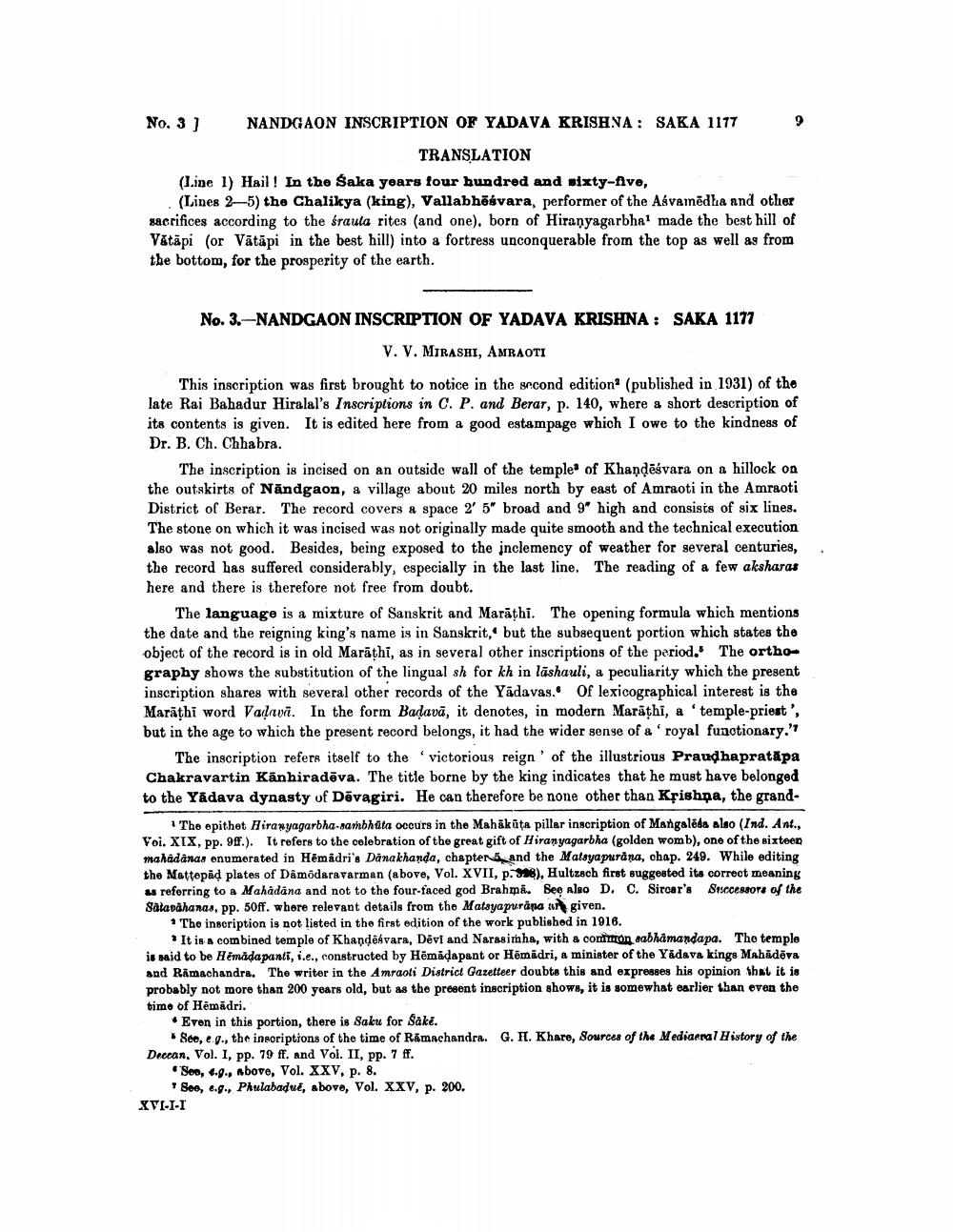________________
No. 3] NANDGAON INSCRIPTION OF YADAVA KRISHNA : SAKA 1117
TRANSLATION (Line 1) Hail! In the Saka years four hundred and sixty-five,
(Lines 2—5) the Chalikya (king), Vallabhāśvara, performer of the Asvamēdha and other sacrifices according to the fraula rites (and one), born of Hiranyagarbha' made the best hill of Vátāpi (or Vātāpi in the best hill) into a fortress unconquerable from the top as well as from the bottom, for the prosperity of the earth.
No. 3.-NANDGAON INSCRIPTION OF YADAVA KRISHNA : SAKA 1177
V. V. MIRASHI, AMRAOTI
This inscription was first brought to notice in the second edition (published in 1931) of the late Rai Bahadur Hiralal's Inscriptions in C. P. and Berar, p. 140, where a short description of its contents is given. It is edited here from a good estampage which I owe to the kindness of Dr. B. Ch. Chhabra.
The inscription is incised on an outside wall of the temple of Khandēsvara on a hillock on the outskirts of Nāndgaon, a village about 20 miles north by east of Amraoti in the Amraoti District of Berar. The record covers a space 2' 5" broad and 9" high and consists of six lines. The stone on which it was incised was not originally made quite smooth and the technical execution also was not good. Besides, being exposed to the inclemency of weather for several centuries, the record has suffered considerably, especially in the last line. The reading of a few aksharas here and there is therefore not free from doubt.
The language is a mixture of Sanskrit and Marathi. The opening formula which mentions the date and the reigning king's name is in Sanskrit, but the subsequent portion which states the object of the record is in old Marathi, as in several other inscriptions of the period. The orthography shows the substitution of the lingual sh for kh in läshauli, a peculiarity which the present inscription shares with several other records of the Yadavas. Of lexicographical interest is the Marathi word Valavi. In the form Badavā, it denotes, in modern Marāțhi, a 'temple-priest', but in the age to which the present record belongs, it had the wider sense of a royal functionary."
The inscription refers itself to the victorious reign of the illustrious Praudhapratāpa Chakravartin Känhiradēva. The title borne by the king indicates that he must have belonged to the Yådava dynasty of Dēvagiri. He can therefore be none other than Kộishna, the grand
1 The epithet Hiranyagarbha-sambhuta occurs in the Mahakūta pillar inscription of Mangaleda alao (Ind. Ant.. Voi. XIX, pp. 98.). It refers to the celebration of the great gift of Hiranyagarbha (golden womb), one of the sixteen mahädänas enumerated in Hēmidri'. Danakhanda, chapten and the Malayapurana, chap. 249. While editing the Mattopad plates of Damodaravarman (above, Vol. XVII, p. 988), Hultzsch first suggested its correct meaning us referring to a Mahädäna and not to the four-faced god Brahma. See Also D. C. Siroar's Successors of the Satavahanas, pp. 50ff. where relevant details from the Malayapurana an given.
* The inscription is not listed in the first edition of the work published in 1916.
* It is a combined temple of Khandökvara, Dēvi and Narasimha, with a common cabhå mandapa. The temple is said to be Hēmädapanti, i.e., constructed by Hēmādapant or Hömadri, a minister of the Yadava kings Mahadeva and Ramachandra. The writer in the Amraoti District Gazetteer doubts this and expresses his opinion that it is probably not more than 200 years old, but as the present inscription shows, it is somewhat earlier than even the time of Hēmādri.
Even in this portion, there is Saku for Sake.
See, eg., the insoriptions of the time of Ramachandra. G. F. Khare, Sources of the Mediaeral History of the Deccan, Vol. I, pp. 79 ff. and Vol. II, pp. 7 ff.
Seo, ...., above, Vol. XXV, p. 8.
Soo, e.g., Phulabadue, above, Vol. XXV, p. 200. XVI-I-I




